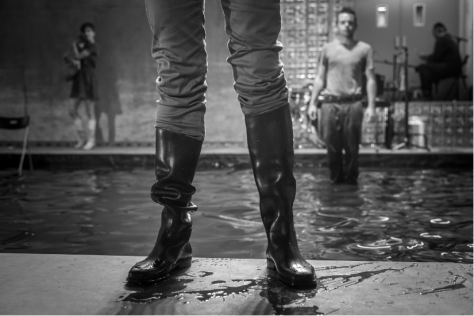The Kammerspiele’s strange mash-up of Buchner’s play Woyzeck with Berg’s opera Wozzeck (an adaptation of Buchner’s play) begins at the end. Or rather, it begins with a narration of the end. We never see the conclusion of the play, but we are reminded of it every moment by the set—a pool of water that spans nearly the entire stage. Characters splash through their scenes, and in fact these splashes are perhaps the set’s biggest contribution. While it’s fun to see actors flop around in the pool, the combination of the constantly sloshing water and Berg’s unsettling tone rows sets nerves on edge. (In this play, that’s a good thing.)

So how do you mix a play with an opera? In this case, an opera singer has been hired for one role (the Doctor) while the other characters speak their lines (or occasionally do a bit of non-operatic singing). Even the spoken lines sometimes have Berg’s musical accompaniment (albeit reduced for three musicians). There seems to have been some attempt to create a social hierarchy: the Doctor sings operatically and the Hauptmann declaims rhythmically and dramatically—only Marie and Wozzeck speak normally. (The Drum Major rarely speaks to other characters, preferring to laugh dismissively at everything, so I won’t count him.) Yet despite this semblance of order, the contrast between the singing and not-singing is very strange. This particular production is decidedly a play rather than an opera, but why not leave it at that, perhaps drawing on Berg for incidental music? Why hire an opera singer for one role—and not even the title role? It’s not entirely clear.
Unfortunately, that’s not the only thing that’s unclear. The staging often descends into chaos, with everyone dimly lit and flailing about in a manner that lacks both beauty and motivation. During these moments (the party Marie attends near the beginning of the play, for instance), it feels like the actors are simply playing around in a swimming pool. Actually, Kristof Van Boven’s Wozzeck always seems like he’s enjoying the pool a bit too much. Although some of his playful bits fit well (like how he “pisses” in the street), he never strays from an attitude of childish cheerfulness. I initially found this an interesting and unexpected character choice, but the lack of range quickly grew grating. I enjoyed the rest of the performances, though. Tobbias Hagge combines a rich bass voice with eccentricity and condescension as the Doctor, and Stefan Merki’s Hauptmann delivers fabulous tirades on morality and virtue. Stefan Hunstein does little but laugh at the other characters and wink at women in the audience, but he does both of those things very well. Oliver Mallison irritated me as the tone-deaf but perpetually singing Andres, but I assume that’s the point. As Marie, Marie Zickwolf seems perpetually innocent, even as she calls herself a whore.

Photo: Julian Röder
That the play is, overall, unsatisfying is largely due to the lack of an ending. Wozzeck asks Marie to “play dead” but never stabs her (though the text obviously implies that he has), then stands still as he talks about going deeper and deeper into the water to conceal the knife. After his monologue, he sits with the Hauptmann and Doctor as they discuss what a lovely murder-suicide he committed. While it’s an interesting concept to replace the acting-out of the ending with the omnipresence of the ending (in the form of the pool-stage), it effectively robs the play of its punch. We don’t reach the play’s late climax when Marie is stabbed, because she isn’t. The action leads nowhere, so the entire show seems rather flat in retrospect. It has ideas, but no clear identity or destination.